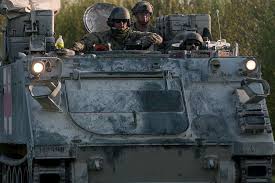
According to sources within Pakistan, the country’s military strength has been bolstered by the introduction of the MAAZ anti-tank vehicle, a product of the renowned Heavy Industries Taxila (HIT). This vehicle, hailed for its innovation in Pakistani military design, is engineered to effectively counter armored threats in combat situations. Modeled after the Talha Armored Personnel Carrier, itself an adaptation of the American M113 APC, the MAAZ demonstrates a fusion of engineering excellence and tactical design.
Characterized by its compact size, the MAAZ is adept at navigating various terrains, including urban environments. Its dimensions of approximately 5.2 meters in length, 2.5 meters in width, and 2.7 meters in height contribute to its agility and adaptability on the battlefield. Powered by a 275 horsepower diesel engine, it boasts impressive speeds of up to 70 kilometers per hour on paved surfaces and 30 kilometers per hour on rough terrain, with a range of around 500 kilometers, ensuring prolonged operational capabilities.
In terms of technological prowess, the MAAZ incorporates advanced systems to enhance its combat effectiveness. These include an automated fire control system for precise targeting, night vision capabilities for low-light scenarios, and a state-of-the-art communication system for seamless coordination with allied units.
Armed with the Baktar-Shikan anti-tank guided missile system, a localized variant of China’s HJ-8, alongside a 12.7mm machine gun, the MAAZ is well-equipped to engage both armored vehicles and foot soldiers in close-quarters combat. The Baktar-Shikan, developed since the 1990s under license, serves as a potent tool for neutralizing armored threats and fortified positions, further solidifying Pakistan’s defensive capabilities.
The Baktar-Shikan missile system stands out for its operational efficiency, requiring only a two-person team for management. Its adaptability across various launch platforms, including vehicles, helicopters, and ground-based launchers, underscores its tactical versatility. This flexibility is further enhanced by its dual direct and top attack modes, allowing for effective engagement in diverse battlefield scenarios.
In terms of dimensions, the Baktar-Shikan missile measures approximately 1200mm in length and features a 120mm diameter, with a weight of approximately 11.8 kg. The launcher itself weighs around 22.5 kg, rendering the entire system lightweight and easily transportable for operational flexibility.
Equipped with a Semi-Automatic Command to Line of Sight (SACLOS) guidance system, operators must maintain visual contact with the target until impact. Its propulsion system, driven by a two-stage solid propellant rocket motor, combined with wire guidance, ensures accurate delivery to the target.
The Baktar-Shikan’s operational range, spanning from 100 to 3000 meters, enables engagement from a safe distance, minimizing exposure to immediate threats for the operators. This capability is particularly crucial for maintaining personnel safety during deployment.
Employing a tandem-charge High-Explosive Anti-Tank (HEAT) missile, the Baktar-Shikan system is specifically engineered to defeat reactive armor commonly found on modern tanks. With a warhead capable of penetrating up to 800mm of armor, it poses a formidable threat to armored targets, enhancing the system’s effectiveness on the battlefield.




